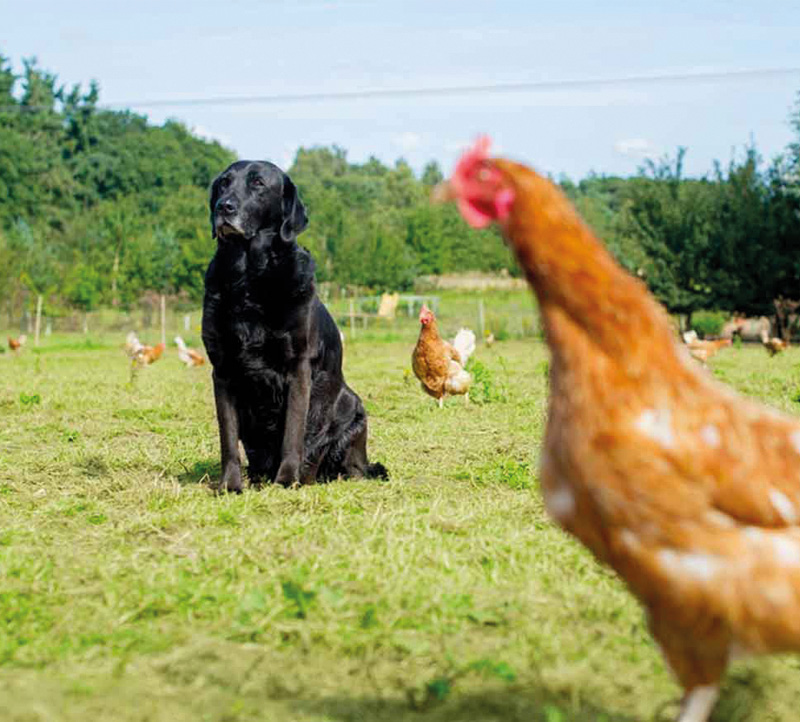The truth about processed food
If the television commercials, advertisements and labelling are to be believed, processed food is the only safe thing to feed a dog. It contains nothing but natural goodness, has been scientifically formulated and is endorsed by experts, including vets. What’s more, if your dog is suffering from any particular ailment, there is almost certainly a food designed to put it right. Pet food manufacturers would have it that they are your dog’s best friend. After reading this article you may begin to feel otherwise. Indeed, you may conclude that you have been misled and deceived.
The law doesn’t protect dogs
There is a considerable volume of British and European legislation controlling the manufacture of dog food but it barely considers the health of the animals eating it. Its real purpose is to protect the human food chain. This quote (the italics are mine), taken from the guidance given to pet food manufacturers, demonstrates how little the government cares:
For pets, the main part of the risk assessment when setting the maximum permitted levels for undesirable substances will generally be the extent to which the animal can tolerate them.
In other words, it is legal to use undesirable substances in dog food providing they don’t kill the animal immediately.
Another disturbing quote from the same guide refers to ingredients:
The material of animal origin used by the pet food industry comprises those parts of animals which are either deemed surplus to human consumption or are not normally consumed by people in the UK, and derived from animals inspected and passed as fit for human consumption prior to slaughter. Animal material of this nature, which is not intended for human consumption, is classified as animal by-products under the EC Regulation.
This innocuous statement allows manufacturers to make their food from so-called by-products, that is to say hooves, tails, testicles, ears and other bits of animal. It also authorises them to use ingredients that are not suitable for human consumption. How so? If the by-products or meat come from an animal that was fit for human consumption prior to slaughter, that’s fine. The meat could be a year old and completely rotten for all the legislators care.
The notes about labelling are also revealing:
The labelling requirements for pet food are less onerous than those for feed for farmed livestock [for humans]. For livestock, the ingredients must be declared individually in descending order by weight, but pet food manufacturers have the option to declare them by category – e.g., ‘meat and animal derivatives’, ‘oils and fats’, ‘cereals’, ‘vegetable protein extracts’.
The significance of this is huge, as it allows manufacturers to hide the actual ingredients being used in their dog food.
A licence to print money
It isn’t just that the legislation doesn’t consider canine health; it is entirely skewed in the manufacturers’ favour. As you can see from the quotes above, they can put in almost any ingredient they want (providing it doesn’t actually poison the dog) and can be misleading in what they tell consumers. How did this happen? Since the industry came into being, manufacturers have managed to persuade both the public and legislators that they are experts and can be trusted. They have used clever marketing techniques and veterinary endorsements to great effect and have been much aided by consumer demand for convenience.
It also helps that for many years the industry has been dominated by five multinational corporations, which between them control around 80% of the worldwide market. They are Nestlé’s (Purina, Bakers &c.), Del Monte (the Heinz range of pet foods), MasterFoods/Mars (Royal Canin, Pedigree &c.), Procter & Gamble (Iams, Eukanuba &c.) and Colgate-Palmolive (Hill’s Science Diet, Nature’s Best &c.).
These companies lobby hard to ensure that their business interests aren’t disturbed by unhelpful legislation. Their biggest single market is the USA, where pet food accounts for $15 billion a year. But the UK market is still sizeable with over £1 billion a year spent on dog food alone.
It isn’t just the overall size of the market that makes it so attractive to manufacturers. Processed dog food is incredibly profitable. As one commentator pointed out:
What most consumers don’t realise is that the pet food industry is an extension of the human food and agriculture industries. Pet food provides a convenient way for slaughterhouse offal, grains considered unfit for human consumption and similar waste products to be turned into profit.
Why processed food is so bad for dogs
Low-quality ingredients
Processed dog food is generally made using extremely low-quality ingredients. As explained elsewhere in this article, that means animal by-products and derivatives and low-quality grain.
It has been cooked
Processed food has been cooked. Cooking alters the food’s chemical structure, destroys much of its nutritional value and makes it extremely difficult for a dog to digest. A processed food diet, because it is cooked, forces the pancreas to work harder and to draw other enzymes from the bloodstream. This can leave a dog physically vulnerable because the enzymes in the blood are supposed to be protecting the body, not aiding digestion. A number of medical studies show that the pancreas enlarges on a diet of processed food. An enlarged organ means excessive function. Excessive function can lead to degeneration. It is a similar story when it comes to amino acids. Cooking at high temperatures alters the arrangement of these acids, making half of them unusable by the canine body.
Manufacturers try to persuade consumers that the canine digestive system has altered and can now accommodate cooked and processed food. Palaeontologists estimate that a period of at least 100,000 years is required before evolutionary changes occur within a whole species. The most accepted theories estimate that dogs began their association with humans between 8,000 and 20,000 years ago. They haven’t, therefore, had time to adapt to eating cooked food let alone processed food, which has only been around since 1860!
In the case of kibble it is also too concentrated and too dry (less than 10% moisture compared to 70% moisture in a natural diet).
It contains grain
Grain is used a great deal in processed food as it is inexpensive and gives it bulk. Some food will contain up to 65% grain, although this may not be apparent from the labelling. In the wild less than 1% of a dog’s diet will be grain. There is a reason why one rarely sees a dog stalking a wheat or rice field. Complex carbohydrates (grains) that dogs eat just end up in an accumulation of lactic acids. Whereas humans can convert complex carbohydrates into sugars and store them for use later (this is what happens when one eats, say, porridge), dogs can’t do either. Most grain in processed dog food ends up going in one end and coming out the other.
It contains fibre
Processed food contains a high percentage of fibre, described as ‘crude fibre’ because it is of such low quality. In most cases the fibre takes the form of peanut hulls, almond shells, empty grain hulls, beet pulp and so forth. None of these things offers any nutritional value to dogs.
It contains preservatives
Chemical preservatives are added to keep the food from going off. Where there are no added preservatives, it is either because the food has been heated to such a high temperature that no preservatives are necessary or because the original ingredients already contained sufficient preservatives.
It contains artificial colouring
Dried and canned food is usually grey. For this reason food colouring is added to give it a more natural appearance. Many trainers believe that the artificial colouring is one of the causes of behavioural issues in dogs.
It contains binders
In the manufacturing process many of the ingredients in dog food are rendered, that is to say they are heated until they turn into a liquid. In order to make it look like kibble or ‘chunks of meat’ chemical binders are added.
It contains unhealthy fats
Many commercial dog foods have fat sprayed on them as a way of making them palatable. Fat may also be added to improve nutritional value. The quality of this fat is usually poor. Fat can be recycled from deep fryers in restaurants and tallow that rises from rendering plants. It may be rancid.
Up to 9 out of 10 canine health issues may be caused by diet
A growing number of vets and nutritionists believe that many if not most of the medical conditions that dogs are being treated for nowadays are a direct result of their diet. Tom Farrington, Honey’s Chief Veterinary Surgeon, considers as many as 9 out of 10 canine health issues – everything from relatively minor problems such as bad breath, flatulence, itchiness, allergies and dry skin through to major problems such as cancer, liver disease, heart disease and kidney disease – may be directly related to processed food. As Ian Billinghurst, author of Give Your Dog a Bone, says:
Our dogs’ disease problems are increasing on a par with their increasing consumption of processed and cooked foods … dog food manufacturers take useless waste from the human food industry and sell it as dog food. Why do they bother? Advertising implies that they are there to promote the health of dogs. Their primary concern is in fact profit. The laws which govern dog food production do not require it to promote health, reproduction, growth or longevity.
If one cares about dogs it is very easy to get worked up about the processed dog food industry. It is a scandal waiting to happen. The only difference between this situation and what occurred with tobacco, asbestos, powdered milk formula, fast food and all the other consumer campaigns that have led to major changes is that the victims of the processed dog food industry can’t speak for themselves.
How long will consumers (and their dogs) put up with the lies?
There’s an Australian study (quoted by Mogens Eliasen) in which it was demonstrated that a dog’s life expectancy increased by 30% when fed a raw, natural diet. Dogs that normally were expected to live until age 12 maintained a healthy life until they were 16 years old. This rather implies that dogs fed a processed food diet are leading shorter lives. Which, in turn, raises the question: how long can manufacturers of harmful processed food get away with it?
For more information and advice please contact Honey’s – we’ll be happy to help even if you never, ever plan to become a customer.
Web: www.honeysrealdogfood.com
Email: info@honeysrealdogfood.com
Telephone: 01672 620 260







